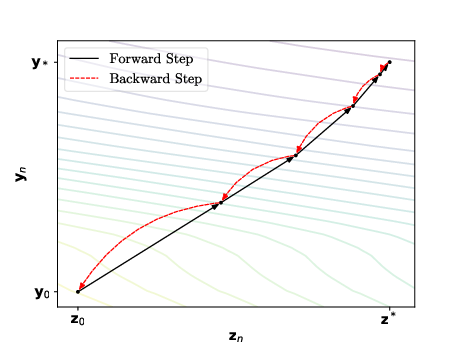- The paper introduces RevDEQ, which uses an algebraically reversible fixed point solver for exact gradient computation with constant memory.
- It significantly reduces the number of function evaluations, achieving improved performance on language modeling and image classification tasks.
- The approach eliminates the need for extra regularization and is straightforward to implement with modern autodiff frameworks like JAX and PyTorch.
Reversible Deep Equilibrium Models: Exact Gradients and Efficient Implicit Architectures
Introduction
Deep Equilibrium Models (DEQs) define neural network outputs as the fixed point of a learned function, enabling implicit-depth architectures with constant memory complexity. While DEQs have demonstrated strong performance across domains, their training is hampered by the need for approximate gradients via the Implicit Function Theorem (IFT), leading to instability and excessive function evaluations. The paper introduces Reversible Deep Equilibrium Models (RevDEQs), which leverage an algebraically reversible fixed point solver to enable exact gradient computation with constant memory and linear time complexity. This approach eliminates the need for regularization and dramatically reduces the number of function evaluations required for training, resulting in improved performance on large-scale LLMing and image classification tasks.
RevDEQ Architecture and Reversible Fixed Point Solver
RevDEQ extends the standard DEQ formulation by introducing a coupled, reversible fixed point iteration. The forward pass is defined by:
yn+1=(1−β)yn+βfθ(zn,x) zn+1=(1−β)zn+βfθ(yn+1,x)
where yn,zn are coupled states, β is a relaxation parameter, and fθ is the equilibrium function. The backward pass inverts these updates algebraically:
zn=1−βzn+1−βfθ(yn+1,x) yn=1−βyn+1−βfθ(zn,x)
This reversibility enables exact reconstruction of the forward computation graph during backpropagation, allowing for exact gradients without storing intermediate activations.

Figure 1: Example of the forward and backward passes in RevDEQ, illustrating the reversible fixed point iteration and exact gradient computation.
The convergence of the reversible scheme is linear in the number of steps, with the same rate as relaxed fixed point iteration. Theoretical analysis shows that both yn and zn converge to the unique fixed point of fθ under contractivity conditions.
Exact Gradient Backpropagation
RevDEQ's reversible solver enables exact reverse-mode automatic differentiation with constant memory. The backpropagation algorithm reconstructs the forward states and propagates adjoints using vector-Jacobian products, matching the gradients obtained by storing the full forward graph. The time complexity is O(N) and memory complexity is O(1), where N is the number of solver steps.
The implementation is straightforward in modern autodiff frameworks (e.g., JAX, PyTorch) by defining custom forward and backward passes for the reversible solver. Mixed precision arithmetic is recommended for addition/subtraction steps to mitigate floating-point error amplification during reversal.
Empirical Results
LLMing: Wikitext-103
RevDEQ is instantiated as a decoder-only transformer, replacing explicit layers with a single equilibrium module. On Wikitext-103, RevDEQ achieves lower perplexity than both DEQ and explicit Transformer-XL models of comparable size, with only 8 function evaluations versus 30 for DEQ. Notably, RevDEQ with 169M parameters achieves a test perplexity of 20.7, outperforming DEQ-Transformer (24.2) and Transformer-XL (24.3).
Scaling experiments show that RevDEQ matches DEQ performance with only 2 function evaluations and plateaus after 8–10 evaluations, indicating superior compute efficiency.
Image Classification: CIFAR-10
RevDEQ is applied to both single-scale and multi-scale architectures, replacing deep unrolled convolutional blocks with a single RevDEQ block per scale. In single-scale settings, RevDEQ achieves 87.5% accuracy with 170K parameters and 8 function evaluations, outperforming DEQ and monDEQ. In multi-scale settings, RevDEQ (5M parameters, 5 evaluations) matches or exceeds the accuracy of explicit ResNet-18 (10M parameters) and ResNet-101 (40M parameters), as well as MDEQ and pcDEQ, while using significantly fewer function evaluations.
(Figure 2)
Figure 2: A single scale of the multi-scale implicit ResNet architecture, illustrating the integration of RevDEQ blocks and downsampling.
Implementation Considerations
- Mixed Precision: Use 64-bit precision for addition/subtraction in the reversible solver to minimize numerical error; other operations can use 32-bit or lower.
- Choice of β: Lower β improves gradient accuracy but slows convergence; values in [0.5,0.9] are empirically effective.
- Normalisation: Stateless layer-wise normalization is preferred inside fθ due to implicit depth; batch normalization is used in explicit downsampling blocks.
- GPU Efficiency: RevDEQ's constant memory backpropagation can be exploited for improved GPU throughput by reducing memory read/write operations.
Limitations and Future Directions
While RevDEQ reduces function evaluations and improves stability, runtime may still exceed explicit models due to solver overhead. Further optimization of GPU kernels and solver implementations is warranted. The approach is readily extensible to other domains where implicit architectures are beneficial, including graph neural networks, generative flows, diffusion models, and inverse problems.
The theoretical framework for reversible solvers may inspire new implicit architectures with exact gradients and efficient memory usage. Future work should explore stateful normalization strategies compatible with implicit depth and investigate applications in large-scale vision and LLMs.
Conclusion
Reversible Deep Equilibrium Models provide a principled solution to the gradient approximation and instability issues of DEQs by introducing an algebraically reversible fixed point solver. This enables exact gradient computation with constant memory, significantly reduces function evaluations, and achieves state-of-the-art results on LLMing and image classification tasks. RevDEQ offers a modular, efficient alternative to explicit deep architectures and sets a new standard for implicit neural models.
